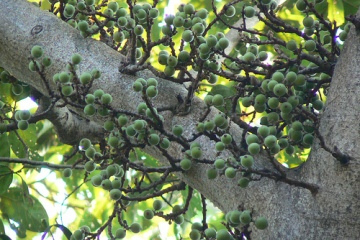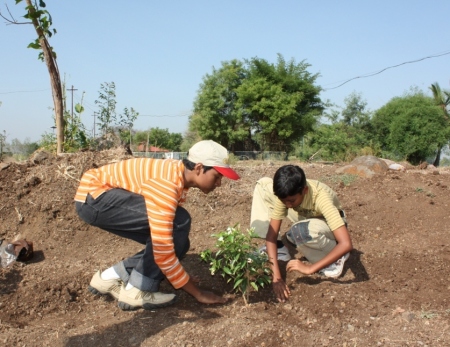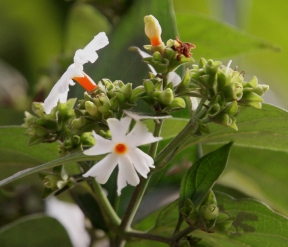Forest and trees
Crafting India's Landscapes-Part II
-The Butterfly Diaries
I love to recall the feel of the bark and leaves of the Banyan, the smell of flowers of the Neem (Azadiractha indica) or the crushed leaves of the Kadi Patta (Murraya koenigii) , the visual extravaganza that the Laburnum (Cassia fistula) provides in summer.
Once we get a feeling of love and appreciation of trees, then and then alone can we make quality choices about the best or most appropriate shrub or tree to be chosen for a spot.

Umbar or Audumbar (Ficus racemosa) - one of the trees best suited for biodiversity. (Image : Dinesh Valke, CC-by-NC-ND)
If you want to attract birds, the Umber or wild fig (Ficus racemosa) is your best bet. If you want a red avenue in summer, it’s the exotic Gulmohar (Delonix regia) you need to choose. For lots of shade with few trees, opt for the Rain tree (Albizia saman).
You can never go wrong by planting Babul (Acacia nilotica) for the welfare of the poorest of the poor – it’s firewood has the highest calorific value.

Babul has the highest calorific value of Indian trees and is consequently of great importance to the common man. (Image credit : Dinesh Valke, under CC-BY-NC-ND)
On the other hand, if you don’t do the learning yourself and rely on the “experts”, expect to find that you have created yet another tree-covered barren landscapes by using Kubabul provided by the Forest Department or orchards of stunted Jatropha if you believe
the agro-industrialists.
The real challenge in growing trees is not planting trees but keeping them alive. We can tackle this is many ways.
One is commitment. Choose carefully based on what level of care you can commit. In other words,
“Bite off only what you can chew”
or
“Cut your coat to suit your cloth”.
Our children of the Painted Storks Nature Club wanted to plant trees in the Sarvatra Bird Sanctuary. But it is not possible (or realistic to expect) for the children to come and water the plants since the sanctuary extends over many acres, has lonely corners,
and very little access to water. So we decided to plant in close vicinity of the Middle Lake Garden which is frequented by the children, where water is nearby and where the gardeners can help water these plants.
The Lake Garden provided little scope for useful addition, so we decided to plant some trees and bushes around the CME Lake Mandir where except for a Tulsi plant (Ocimum sanctum var krishna) in front and a Tamarind tree (Tamarindus indica) above the temple,
no other plants were present. It is just 30 meters from the garden and on the lakeshore itself.
We chose our plants carefully. Since we were planting around the mandir (temple), the emphasis was given to shrubs with bright flowers or having perfumed flowers. We tried to choose those which are commonly used for worship in Maharashtra. We also decided to
plant three small-statured trees which would highlight the mandir’s background. We chose well-developed saplings for plantation which were sturdy enough to survive (unintentional) neglect and which already had some flowers so as to enthuse the children and
give them a foretaste of how the garden would look. It was more expensive but worth it.

Children plant a shrub with rapt concentration.
The Painted Storks planted the following shrubs on the side of the temple :
* “Juhi” (Jasminum auriculatum)
* “Mogra” or “Madanbaan” (Jasminum sambac)
* “Tagar” or Crepe Jasmine (Tabernaemontana coronaria)
* “Anant” (Gardenia jasminoides)
* Red Hibiscus (Hibiscus rosa-sinensis)
* “Raj Chameli” (Jasminum nitidum)
* “Chameli” (Jasminum flexile)
* “Zai” (Jasminum officinalis)
* “Sarpagandha” (Rauwolfia serpentina), a medicinal plant.
"Juhi" (Jasminum auriculatum)
"Tagar" (Tabernaemontana coronaria)
Behind the temple we planted three saplings of small trees having beautiful flowers :
* “Parijaat” (Nyctanthes arbor-tristis).
* “Savni” or Crepe Myrtle (Lagerstroemia indica).
* “Sonchafa” or “Champak” (Michelia champaca).
"Parijaat" (Nyctanthes arbor-tristis) (Image:JM Garg, CC-BY-SA 3.0)

The first tree being planted - a "Parijaat".
That is it – exactly twelve plants, but well chosen, well planted and well-located. What do you think are the odds of survival of these twelve than the desultory planting of many more? And when they do survive which will give the better effect?
One could of course say, don’t confuse gardening with tree-plantation, but the principles are the same.
Problems and dilemmas will arise in this activity, as it does in all of mankind’s ventures. The most important one would that as to how to water the plants regularly. In my opinion, this would be the most difficult of all tasks associated with nurturing trees.
When we know that we cannot come often to water the plants, should we not plant?
We could choose to plant drought resistant native species such as Neem and Babul. We could jury-rig drip irrigation with plastic bottles and tubes which would need less water and give a longer effect. We could mulch the saplings – the mulch helps retain the
water, reduces erosion, suppresses weed growth and seed germination and adds to the fertility over time. We could water in the evening where our water loss due to evaporation will reduce. We could choose to come at a fixed intervals as per our convenience
– say once a fortnight or month, to water the plants accepting the triage due to the environment. We could plant hardy two-three year old saplings rather than very small saplings.
By applying our mind, and by matching our effort to our thought, we can increase the chances of survival of the trees.
If I were to plant a few hectares of arid area in Maharashtra, for example, I would choose native species such as Babul and Ber (Zizyphus jujuba) for the general backdrop, add a few Ficus to form the focal points and plant many interesting but scarce trees.
A few Agaves would help prevent soil erosion in the monsoon run off along with some simple landscaping, a few legumes would help improve the soil condition. There would also be a few creepers, many shrubs (both perennial and annual) and definitely useful grasses
and bamboo. Maybe a few exotic Gliricidia trees to provide ready-made green manure for the caretakers. Amidst these, a few trees or shrubs carefully selected to provide all kinds of resources (nectar, food, shelter, nesting etc) to the typical biodiversity
of that place.
That’s all I can come up with off the cuff. But in reality, the tree plantation scheme for this otherwise hypothetical scheme would be worked out carefully in much greater detail and perhaps even plotted graphically on a map. The location, aim, species available
would all be considered. A planting schedule over two-three years would be considered. The civil engineering works would be restricted to a bare minimum. Nothing more than a fence, water tank or supply. A shed for the forest guard and perhaps minimal amenities
in a place under a shade tree where the nature-lovers can sit, rest, enjoy nature, have their meal etc.
However, I would expect the record-keeping and science to be top class. None of the careless generalities thrown in by so-called experts. The practice of science in even such a routine activity as tree-plantation should be second to none.
That then is my view of tree-planting…
Let’s not just plant trees, let’s craft Nature.
Credits:
My sincere thanks to Mr Nandan Kalbag of www.gardentia.net who dotes on his son-in-law (yours truly) and fielded telephone calls on asking what plants to choose at all times of the day and night.
Members of Indian Tree Pix/EFlora India such as Mr JM Garg & Mr Dinesh Valke (and others) who made images available on the internet with Creative Commons licenses.
|